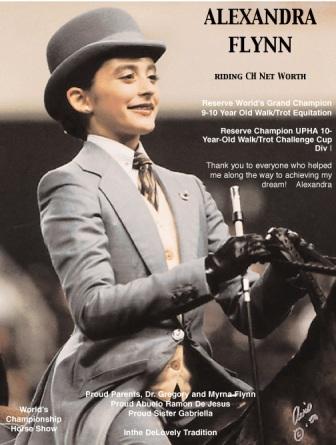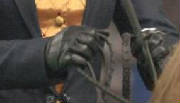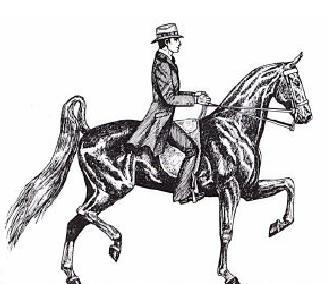|
In addition to the balanced, straight
seat, good equitation also includes the effective use of the rider's hands. Over the centuries, a standard position,
dictated by the need to communicate clearly with the horse, while avoiding undue stress and strain on the rider, has evolved.
Very simply, in whatever you are trying to accomplish with a horse, the reins should always be part of a straight line between
the horse's mouth, through your wrist, to your elbow. This position allows your arm to hang relaxed from the shoulder, puts
no excess pressure on your wrist and allows instant, clear signals to pass from the horse's mouth to your fingers and from
your fingers to his mouth. The upper body, including the arms and hands, should give the appearance of elegant style and complete
control, but without the impression of stiffness, posing, or exaggeration.

Hands should be quiet and light, with flexible (not locked) wrists and held in an easy position, neither perpendicular nor
horizontal to the saddle and should show sympathy, adaptability and control. Keep the fingers tight enough around the reins
so that they do not slip through and so that you won't have to continually adjust your hands, making you look fidgety and
uncomfortable but not so tight as to make communication difficult. Also, keep in mind that a simple squeezing of the fingers
around the reins can often be enough to get your horse's attention and aid you in bending or creating a frame. A forgiving,
following hand shows judges that as a rider you are competent and educated. It also makes for a prettier picture than having
a hand that is stuck in place and constant jarring a horse's mouth and inhibiting good, steady contact with the bit.
You hold two reins in each hand, the
snaffle coming up through the bottom of your hand, below the little finger, held in place at the top of the hand between the
thumb and index finger, the curb coming up between the little finger and ring finger, also held in place between the thumb
and index finger.
| 1 Finger Rein Hold |

|
| photo by Howie Schatzberg |
| Two Finger Rein Hold |

|
| photo by Howie Schatzberg |
Wrists
should always be held straight so that you can always see the knuckle of your thumbs. They should not be bent to the inside
or the outside and should never be cocked upward or downward. Think of holding a pistol to shoot on a range to get a picture
of the approximate way wrists should be…always. If the rider has to bend their wrists to use the reins, the reins are
too long and it makes the rider look like they don't even know how long the reins should be and furthermore could not control
the horse if something went awry.
| Upper Body Position For Lower Headset |

|
Arms and hands should be held in a comfortable, relaxed manner and there should
be a straight line from elbow to wrist to the horse's bit. Keeping a bend in your elbows should allow your hands to
follow with the motion of the horse so that contact is always achieved between you and the horse. Keeping a straight
line from the bit to the elbow also gives the greatest amount of feel.
Thoughts
Why are hands held higher than the horse's mouth in Saddle Seat? Lifting the hands up higher
than the straight line from the horse's mouth tells the horse to elevate its front end. The lifting of hands comes from bending
the elbow not lifting the upper arm.
|



